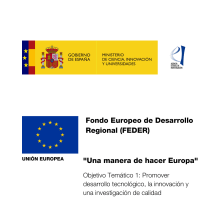Projects
Projects at a Glance
BRIDGE - Bridging the gap between synthetic polymers and biopolymers physical and chemical properties
The project BRIDGE is aimed at closing the gap between studying polymers and biopolymers. Traditionally, these materials are "at home" in the disciplins of soft matter physics and of biophysics, respectively. Our interdisciplinary approach opens new avenues, of which we explored morphology and dynamics. A special focus was on the role of water, as solvent, and as adsorbed layer.
FunMolSys - On-surface Synthesis of Functional Molecular Systems
This is a collaborative research project funded by the Spanish Research Agency (AEI) for synthetizing functional complex carbon-based molecular nanostructures with atomic precision and testing their potential operability as functional units in various technological applications, such as spintronics, topological engineering, (opto)electronics, thermoelectricity, and chemical and molecular sensing and filtering. FunMolSys combines the work of six Spanish research groups in Galicia (CiQUS at the University of Santiago de Compostela), Euskadi (the CFM, Centro de Física de Materiales - CSIC-UPV, and CIC nanoGUNE), Aragón (the ICMA, Instituto de Ciencia de Materiales de Aragón – CSIC-UZ), and Catalunya (the ICN2, Instituto Catalán de Nanociencia y Nanotecnología). In the last years, FunMolSys has produced novel strategies for synthesis of customized graphene platforms over metallic surfaces and identification of their new electronic and magnetic properties with a combination of multiple experimental methods, theoretical tools, and multidisciplinary expertise. Within FulMolSys, the research groups of Theory and nanoimaging, led by Profs. Artacho and Pascual, respectively, contributed with a sub-project entitled “Magnetism and topological states of on-surface engineered molecular nanosystems”
MicroMech - Nanomechanics of Microbial Infection:Towards Mechanopharmacology
Microbes use surface proteins to infect hosts, with bacterial adhesins, like long filaments, crucial for attachment, resisting mechanical forces from pico to nanoNewtons. This resistance is vital for anchoring in shear-rich environments like urinary tract infections. Understanding the link between adhesin mechanical resistance, attachment ability, and pathogenicity remains incomplete. The proposal aims to study Staphylococcus aureus mechanics in active endocarditis, exploring adhesin proteins Clumping factor A (ClfA) and Fibronectin-binding protein A (FnBPA) connections to infection. Techniques span atomic force spectroscopy, magnetic tweezers, and clinical S aureus strains, seeking to correlate pathogenicity with adhesin mechanics and discover molecules to prevent infections, contributing to Mechanopharmacology.
SURFNANOCUT - Knowledge based cutting for surface engineering of aeronautic and automotive materials: understanding the fundamentals of cutting process through micro-nano structure analysis
The study of the microstructure of machined metal surfaces plays a key role in understanding the thermomechanical conditions at the tool/workpiece interface and allows us to pinpoint the driving forces that trigger microstructure formation processes. In this project, we are investigating these microstructural processes in a number of key materials for the aerospace and automotive industries: AISI 1045 steel, Inconel 718 and Aluminum 7475. The idea of the project is to understand the patterns of surface layer microstructure formation during the cutting process and use this knowledge to target improvements in the surface properties of the finished part by changing the cutting parameters.
NOVASPEC - Novel instrumentation and applications of IR & THz nano-spectroscopy
The project aims to develop ultrahigh-resolution microscopy techniques using s-SNOM and nano-FTIR spectroscopy to map material properties and nanoscale light fields in novel materials and photonic devices. The main objectives include advancing the instrumentation, applying it for chemical characterization of polymers, and exploring polaritons in 2D materials for novel infrared detectors and sensors.
Evaporador - Evaporador para el crecimiento de películas delgadas en alto vacío
El proyecto tiene como finalidad la compra de un evaporador de alto vacío provisto de dos tipos diversos de evaporación de materiales y un equipo de ataque físico por iones. Las características de este equipo nos permitirán ampliar los materiales disponibles en nuestra sala blanca, así como acometer procesos de fabricación con condiciones ideales en cuanto a limpieza de intercapas y con un nivel ideal de rotación de usuarios.
PHOTOTHERMAG - Nanomagnet logic via photothermal excitation of nanomagnetic networks
The project explores a new concept of nanomagnetic logic devices based on optothermal activation of hybrid plasmonic-magnetic metamaterials to implement ultralow power, ultrafast, and optically controlled reconfigurable Boolean and neuromorphic/stochastic computation schemes.
SCARFACE - Spin Control And Related effects at interFACES and heterostructures
This project studied spin materials and processes for beyond-CMOS devices, with a special focus on spin-to-charge conversion (an effect that allows inserting and reading spin information in a circuit without the need of magnetic materials) and molecular spinterfaces (i.e., the way in which a molecular layer affects and it is affected by a ferromagnetic underlayer).
NS-PC - New frontier of nano-space using protein crystals for telecommunication and medical applications
Nano-spaces based on organic molecules, including porous coordination polymers and metal-organic frameworks (PCP/MOF), find applications in storage, separation, and transport. Protein crystals offer larger nano-spaces (4.5-100 nm) and biocompatibility. The NS-PC project focuses on synthesizing, characterizing, and applying protein crystals, utilizing cage-shaped proteins to confine organic molecules or nanoparticles. Peptide-functionalized proteins enable crystalization through conventional and gene-engineered methods, forming binary or ternary protein crystals. These crystals could serve as containers for molecules or scaffolds for nanostructures. Protein crystals are proposed for developing periodic magnetic nanostructures, aiding magnon physics and microwave device innovation. Biocompatibility opens avenues for drug delivery and imaging agents, potentially revolutionizing healthcare with larger-capacity carriers. The project bridges fundamental research and practical applications.
MATBIOCAT - Design of Hybrid Protein-Inorganic Nanostructured Biomaterials for Advanced Heterogeneous Catalysis
MATBIOCAT focuses on merging synthetic materials with biomolecules to create functional nanostructures, enhancing performance in extreme conditions for biotransformation processes. The aim is to improve biocatalyst stability in organic solvents, high temperatures, and extreme pH values. Three main sections involve enzyme encapsulation in polymeric networks, designing metal-based nano/microstructures, and creating enzymatic bioreactors. Collaboration across enzymology, polymer chemistry, inorganic chemistry, and material science contributes to this multidisciplinary effort. Challenges include ordered placement of biocatalysts in stable films or microstructures to preserve catalytic performance. The project's ultimate goal is to develop advanced biomaterials with improved enzymatic function, holding potential for various applications.
By funding program
Contact

Yurdana Castelruiz
Projects Manager
+ 34 943574022
y.castelruiz[at]nanogune.eu

